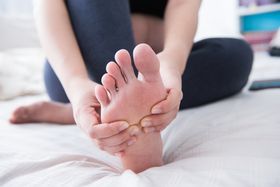How to Reduce Pain from Past Injuries to Improve Quality of Life
Updated December 20, 2024.

As athletes surely know, age matters. Even professionally trained athletes feel the toll time takes on their tendons and ligaments. They become stiff, lose flexibility, and are significantly more prone to injuries. And if that’s not enough, this often leads to a chicken-and-egg situation: The pain in your feet causes you to exercise less or incorrectly, leading to further reduction in mobility and increasing the chance of more pain.
The negative impact doesn’t stop there. When feet are incorrectly positioned, the entire body is set off balance. Knee and back muscles are forced to compensate, resulting in further injury and damage. The cascading effects of these issues, combined with the cumulative impact of previous sports-related injuries, can be felt even years after an athlete retires and significantly reduces their quality of life.
The mobility impairment and pain join many other struggles waiting for former athletes as they retire. As described by Karen Gallagher, a senior postdoctoral research scholar at the Global Sport Institute: “You have put your body through a whole lot, you are more likely to sustain concussions (injury)... and you are losing the camaraderie.” Thus, it is even more crucial to make sure retired athletes have the best tools at hand to ensure optimal foot health and mobility.
The Good News? There’s a Way to Break This Cycle
Good foot support can make a dramatic difference, prevent further damage, and help with safer movement. Wide, stable shoes are a good starting point since they are readily available. Ideal protection, however, comes from a customized fit and personalized design.
Custom orthotics do more than support, as they fill the space between the inside and the shoe and the foot arches (3 in total). Those are ideal conditions for both comfort and healthy foot function, leading to a noticeable improvement.
“A combination of supportive shoes and well-crafted custom orthotics is the ideal setup,” said Philip Wells, Head Podiatrist at Upstep Custom Orthotics. On top of their ‘known’ benefits, they improve overall walking mechanics (gait) via longer strides. Simply put, you take fewer steps, which means your feet, knees, hips, and back sustain less impact.”









